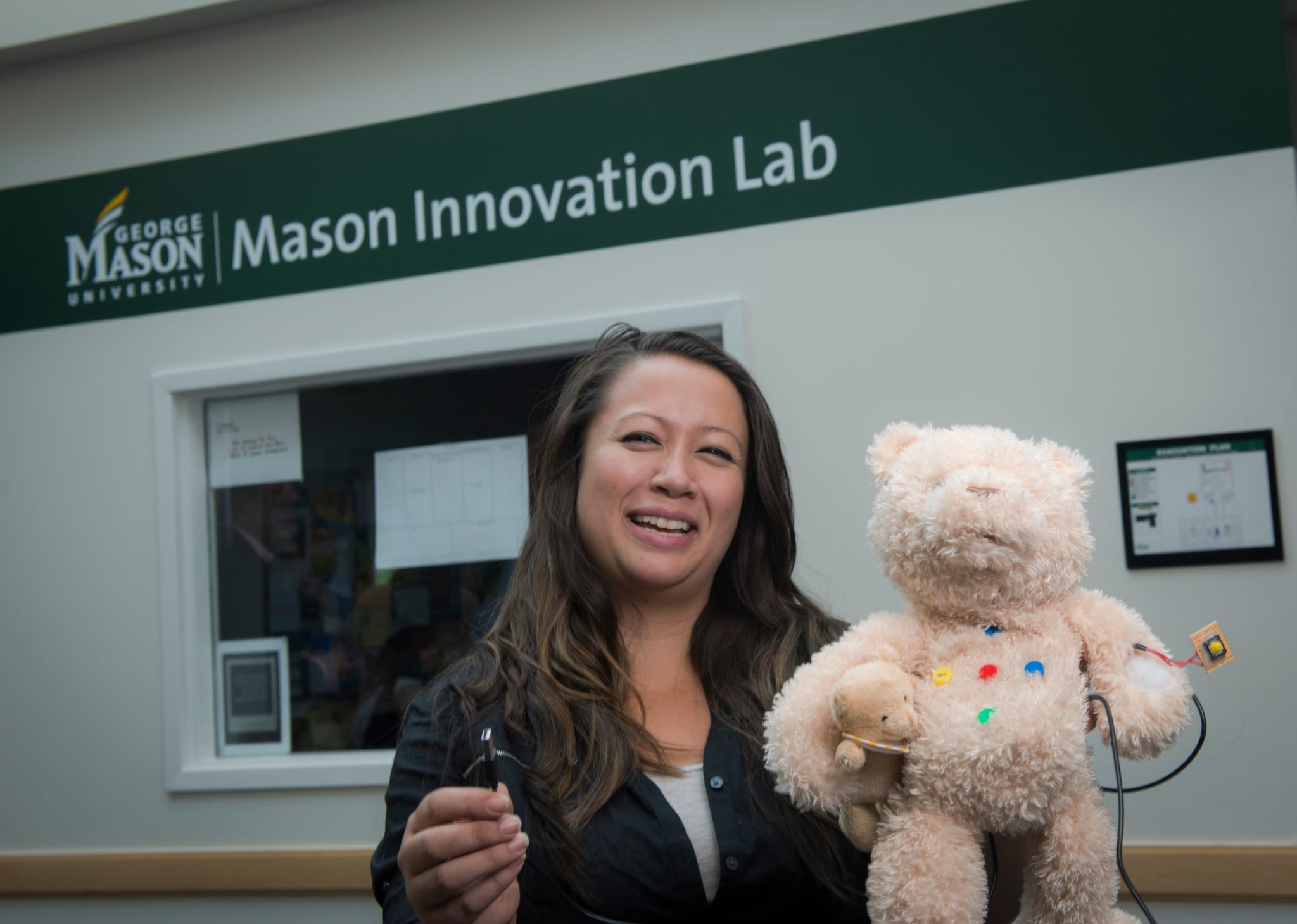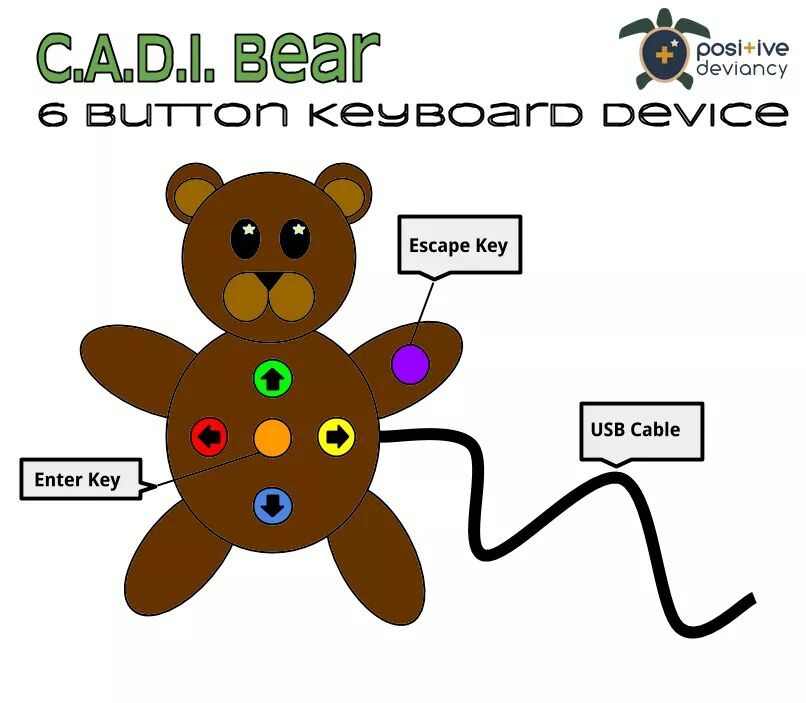Thanks to one determined young woman, children with autism can now learn through a whole new paradigm.
Jade Garrett is the founder of the Positive Deviancy. Her company focuses on making stuff animals comprised of hardware devices that enable children with autism to interact with computers.
“Now more than ever, I see just how much we [as a society] haven’t taken a step back to look for new ways on how technology and designing hardware could make a huge difference for these kids,” she told RIZZARR.
VIEW PHOTOS: THE IMPACT OF POSITIVE DEVIANCY
Along with leading her company, going to college, and being a mom, Garrett is quite busy leveraging the impact of entrepreneurship. She works as a Manager for the Center for Innovation and Entrepreneurship at George Mason University; is the graduate student representative for the Learning Environment Group at GMU; and is the founder of a new women entrepreneurship support group called, Startup Vixens; is the STEM Outreach Coordinator for the university’s Mason Innovation Exchange; and is opening the first Makerspace called MIX@Innovation Hall.
Garrett said she hopes these experiences will help learn new ways to get younger kids involved with developing and making inventions through her company in the future: “If I can scale my business by doing more outreach and teaching kids how to build things like the CADI Bear, then they take what they have learned and make/invent/create more things/ideas that can help the world.”
We wanted the change to get to know more about Garrett’s inspiring journey in starting her company and how she plans to change the world.

Garrett placed as a finalist in George Mason’s Dean Business Plan Competition in March of this year for her company. (Photo courtesy of Positive Deviancy)
RIZZARR INTERVIEW WITH JADE GARRETT
1. What prompted your interest in helping children with autism?
I used to be a Water Safety Instructor for Fairfax County in Virginia, and I also worked in this program, called Adapted Aquatics. I would teach people who had challenges with swimming. This was mostly people who had cerebral palsy, people who were missing limbs, and those with other situations as well. When I started teaching adapted aquatics, I only had about 2-3 kids with Autism that would work with a month. By the time I stopped being a Water Safety Instructor four years later, I was primarily working with children with Autism (15-18 children per month) and it really worried me that in in just four years I was able to see firsthand just how rapidly Autism was being diagnosed. After working with these amazing kids for a long period of time, I grew close with some of them and the more that I learned about what autism really was, the more that I felt compelled to take action on doing everything in my power to help them.
2. Was there a situation that really impacted you when you were trying to understand autism?
I remember this one time that I was trying to teach this one kid to put his face in the water and every time that the water would reach over his shoulders he would begin to panic and kick and do everything in his power to get away from me. Then one day, I met him at the front desk before he got changed into his swim trunks and I saw that he was wearing really big headphones. They were huge – covered his ears completely. I asked his Dad why he was wearing such large headphones and his Dad said that he was really sensitive to certain sounds and he seemed to really hate having cold ears so he liked to wear them around most of the time.
Then, the past two weeks of our struggle came back and hit me right in the face. I realized that the pool temperature is much colder than bathwater temperature and the only way for him to communicate that to me was through letting me know that he was not comfortable. I was so ashamed of myself. I was definitely right about the issue being a listening problem. It was just that the person who wasn’t listening was me. After many Skittles and coaxing, he finally put his head in the water and was able to swim after a month. It was a really life-changing for me on how narrow my perspective was when it came to something that I did not understand.
3. How did your idea for Positive Deviancy ignite?
Working with kids on the Autism Spectrum in the pool is what fueled me. Then, combining many aspects that I really love in different ways and combining it all into making these devices is what made me explode. I never really felt like I had a real purpose when I was doing stuff. When I finally had an opportunity to work through the Google Summer of Code program, I built this keyboard that was integrated into a teddy bear. No one ever thought of addressing a child’s emotional needs FIRST when designing hardware for children on the Autism Spectrum. I knew that when I had finally used the same approach on creating that bear as I did with that kid. That sealed the deal for me. What I was meant to do was so warmly received.

Jade Garrett attends Patriot Demo Day outside of the Mason Innovation Lab. (Photo: Evan Cantwell/Creative Services/George Mason University)
4. What have been the greatest challenges that you’ve faced in starting Positive Deviancy?
My challenges have been trying to make everything work (being a good Mom, taking Undergrad and Graduate courses at Mason, having to work side jobs and taking out student loans when I have enough Financial Aid and scholarships where I don’t have to just so that I can send my daughter to preschool while I am going to school and working). I could NEVER have even dreamed about any of this if it was not for my Mom. I am so scared that I might not be able to show my Mom just how much this means to me and my daughter for putting what she has wanted more than anything in the world on hold, so that she can give me the one chance I could ever have of breaking out of the circumstances that would have made me a statistic instead of letting me shine. My greatest challenge is that no matter what, I will never be as amazing a human being as my Mom is.
5. What have been the moments that have truly touched your life as you developed your company?
I have these moments every time that I see a connection that was made with a child that was not there before when they can use computers.

Garrett says she continues to be touched when she see children interacting with her company’s developments. (Photo courtesy of Positive Deviancy)
6. How do you think your products will change people’s perceptions of autism in years to come?
I hope that it can inspire more people to see something that they can change in the world and have them act on it. That is why I love permission-less inventing so much and I have given the design of the bear to be open-sourced so that if someone else can make a connection that helps people by making changes on the CADI bear that could improve someone else’s life. That is what I want to change – progress first then profit.
7. What advice would you give to someone who is trying to fulfill a dream but is having a hard time doing so?
– Don’t ever be restrained by someone telling you that you can’t do something. That is the scope of limitations that they have or see for themselves NOT you.
– Always be really aware of you take advice from – you would never ask your chronically single friends for marriage advice so don’t take advice from someone who has no clue about what your journey holds.
– Working hard sucks – work smart and when you come to a point when you have to work hard, you won’t be burned out.
– Never settle – the definition of settling is slowly sinking and if you want to sink then all you have to do is stand still and be complacent.
-Always keep learning, adapting, and laughing. Failure speeds up the learning process. The more that you fail in the beginning, the smarter you will be for what the future holds for your success.









